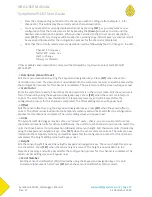
NRG USER MANUAL
SymphoniePLUS3 User Guide
SymphoniePLUS3_DataLogger_Manual
Rev. 17
[email protected] | Page 12
31 December 2018
Average, Standard Deviation, Maximum and Minimum values are recorded for all wind speeds
and most analog channels at every 10 minute interval.
Free Symphonie Data Retriever Software is included and produces versatile tab-delimited text
files. Data files can be used with a wide range of data processing software, including SQL
databases, Microsoft Excel and Access, and more. International numeric formats are supported.
LCD screen and number keypad make programming simple.
Real-time clock with separate CR2032 battery provides accurate and reliable time stamping.
Wiring panel provides additional electro-static damage (ESD) protection for each input channel.
SymphoniePLUS3 runs on two alkaline D-cells (included) for up to one year, depending on
sensor configuration.
iPack kits for CDMA cellular, GSM cellular, and satellite communications provide remote data
collection via e-mail.
Loggers installed with iPacks allow remote changes to sensor configuration and communication
parameters via email.
Symphonie Data Retriever Software version 7 is compatible with data from SymphoniePLUS3,
Symphonie, Wind Explorers, 9200-PLUS, and 9300 series loggers and their readers (DataPlug
Reader, EEReader II).
Improved support for DBCS systems.
Data filtering in Symphonie Data Retriever Software can exclude icing data and faulty sensor
data from reports.
Support for SMTP authentication for iPacks version 14 and later.
iPackGPS firmware can be upgraded via e-mail or on site using SDR and programming cables.
POPAuto feature included with Symphonie Data Retriever Software automates extraction of
emailed data.
Convenient access to complete sensor history information in the Site Information Editor screen.
Customized ASCII export available.
Integrated Global Positioning System (GPS) in iPackGPS
More detailed iPackGPS info such as iPackGPS serial number, signal strength, modem identifier,
and firmware version available in header of each raw data file.













































